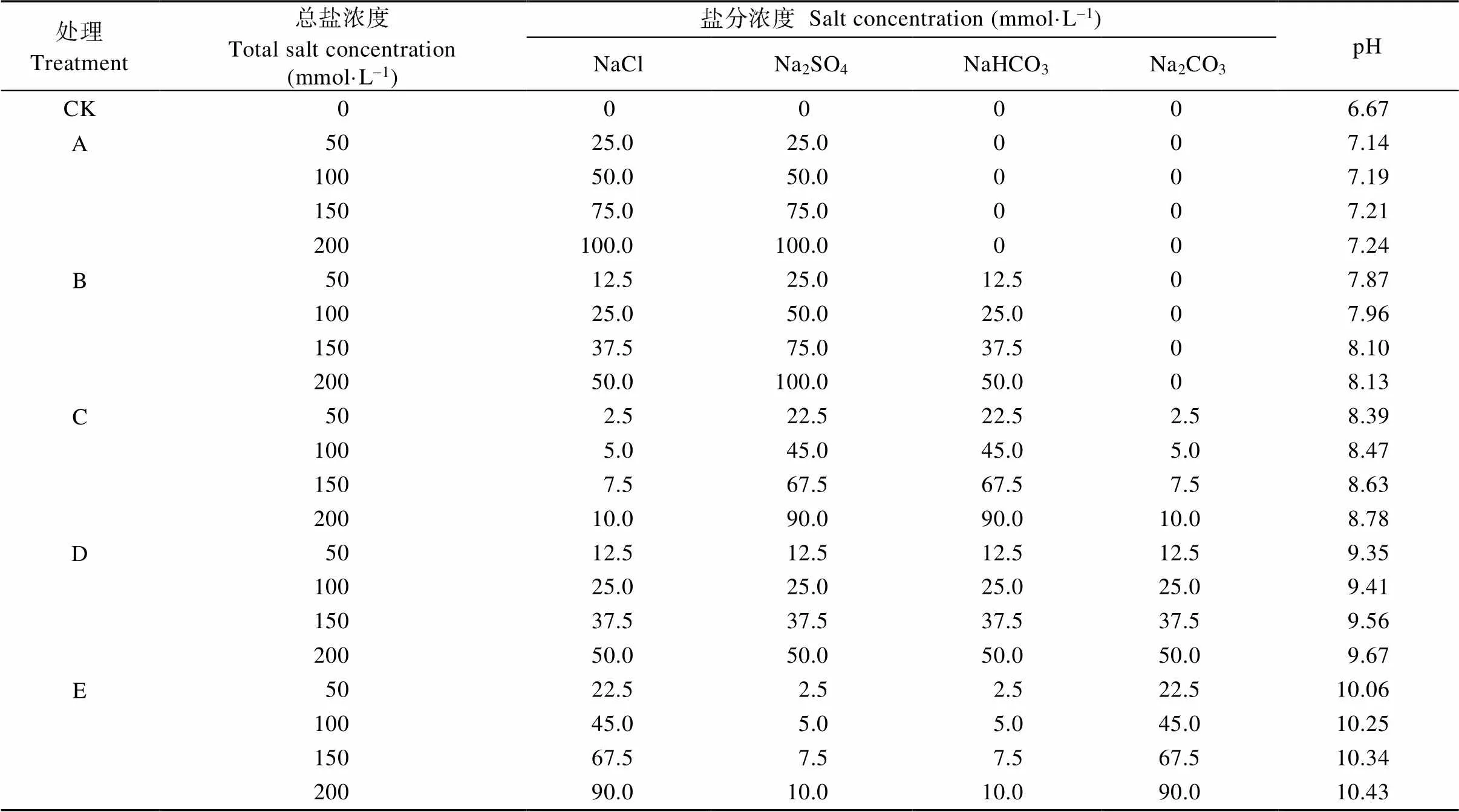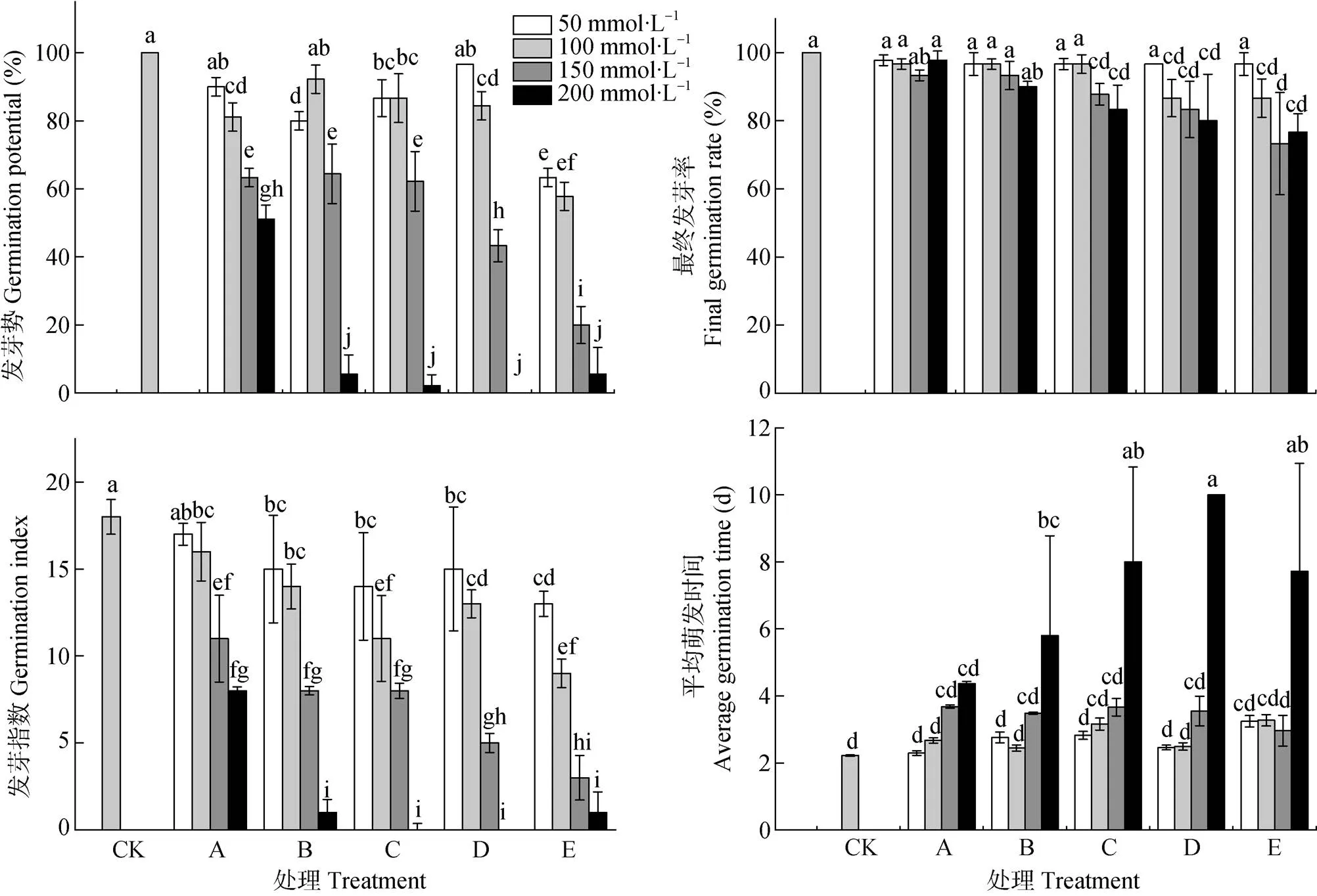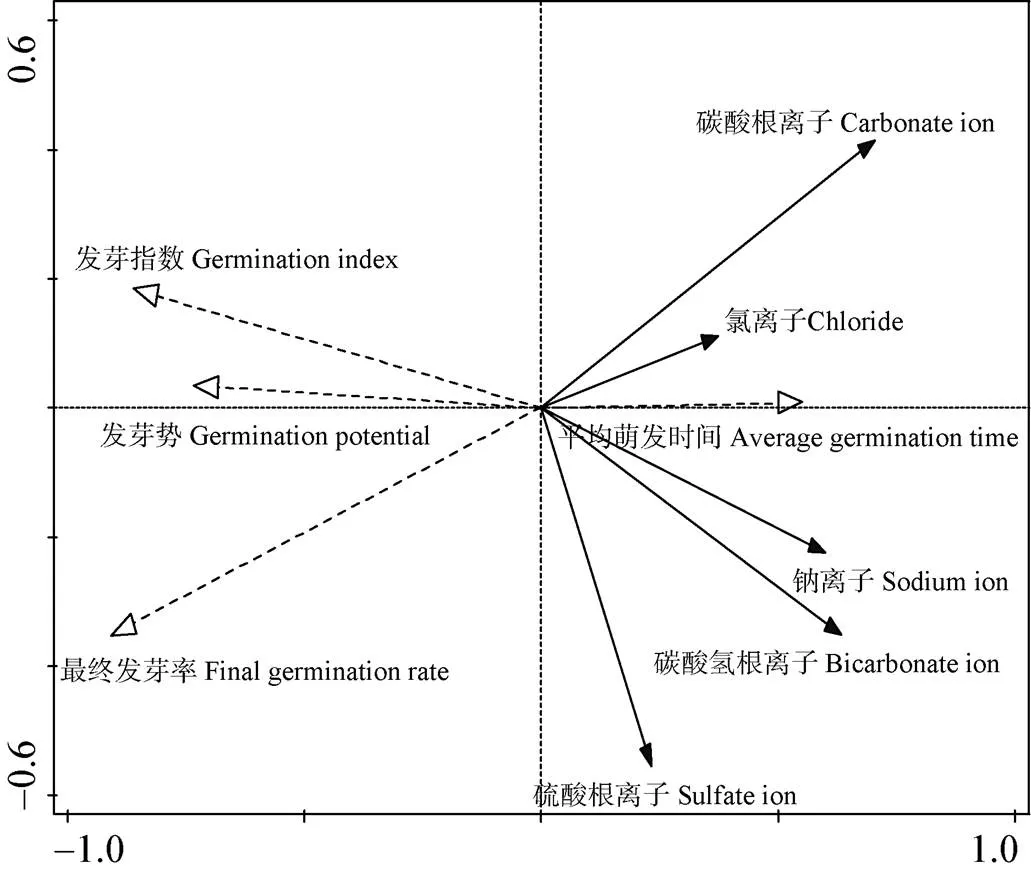盐碱复合胁迫对水稻种子发芽的影响*
金梦野, 李小华, 李昉泽, 黄占斌**
盐碱复合胁迫对水稻种子发芽的影响*
金梦野1, 李小华2, 李昉泽1, 黄占斌1**
(1. 中国矿业大学(北京)化学与环境工程学院 北京 100083; 2. 华北地质勘查局综合普查大队 三河 065201)
为研究盐胁迫与碱胁迫复合对水稻种子发芽的影响, 采用模拟试验方法, 将两种中性盐(NaCl、Na2SO4)和两种碱性盐(NaHCO3、Na2CO3)按照不同比例[NaCl︰Na2SO4︰NaH∶CO3︰Na2CO3分别为1︰1︰0︰0(A), 1︰2︰1︰0(B), 1︰9︰1︰0(C), 1︰1︰1︰1(D), 9︰1︰1︰9(E)]混合, 每个混合比例设不同总盐浓度(50 mmol·L–1、100 mmol·L–1、150 mmol·L–1、200 mmol·L–1), 模拟20种盐碱胁迫环境, 以去离子水作为对照(CK), 研究不同盐碱混合胁迫对水稻种子发芽的影响。结果表明, 水稻种子经两种中性盐混合胁迫溶液培养后, 与CK相比, 发芽率、发芽势、发芽指数的降幅分别为9.2%~74.4%、10.0%~48.9%、5.6%~55.6%, 平均发芽时间延长3.2%~96.4%; 随胁迫溶液中碱性盐比例的增加, 与CK相比, B-E组发芽率分别降低8.9%~96.5%、15.0%~98.0%、7.5%~98.7%、18.9%~95.7%, 发芽势分别降低20.0%~94.4%、13.2%~97.8%、3.3%~100%、36.7%~ 94.4%, 发芽指数分别降低16.7%~94.4%、22.2%~100%、16.7%~100%、27.8%~94.4%, 平均发芽时间较CK延长0.8~4.5倍, 说明中性盐和碱性盐的混合胁迫溶液对水稻种子发芽的抑制作用更强。将在盐碱胁迫溶液中未萌发的水稻种子转移至蒸馏水中培养7 d后, 水稻种子的最终萌发率均达73.33%以上, 表明胁迫溶液没有破坏水稻种子的活性, 只是暂时性抑制了种子的萌发。试验结果表明: 与单施中性盐比较, 中性盐与碱性盐混合胁迫作用对水稻种子萌发的抑制作用更明显, 且在中性盐与碱性盐混合溶液浓度达200 mmol×L-1时, 种子发芽率接近0。
水稻; 盐碱复合胁迫; 种子发芽; 发芽率; 发芽指数
盐碱土壤是重要的土壤退化类型之一, 广泛分布于世界干旱和较干旱地区[1]。世界盐碱化土壤面积约为9.5×108hm2, 我国盐碱化土壤面积约占世界总盐碱土壤面积的1/16, 且呈现逐年增加趋势[2-3]。盐碱土壤中含盐量较高, 破坏土壤中的渗透压平衡导致植物吸水困难, 同时也会干扰植物体内的离子动态平衡和造成营养缺失, 降低农作物的产量[4]。
土壤盐化和碱化对植物的生长、发育、繁殖以及分布等生理生态特征有一定影响, 危害程度大小依次是盐碱胁迫、碱胁迫、盐胁迫[5]。盐化和碱化是影响植物生长发育的两种主要非生物胁迫[6], 盐胁迫主要包括渗透胁迫和离子毒害两种, 盐胁迫会使植物由于缺水和Na+累积表现为细胞膜结构和稳定性遭到破坏, 同时破坏细胞中的渗透压平衡, 造成植物生长发育不良的现象[7-8]; 而碱胁迫不仅包括渗透胁迫和离子毒害, 还有较高的pH会造成土壤中营养元素的固化, 导致植物体内营养失衡[9]。盐碱胁迫会导致水稻(L.)种子在土壤中的发芽延迟[10], 而种子发芽时期往往是对盐碱胁迫十分敏感的阶段, 也是决定种子存活的关键生长阶段[11]。因此, 盐胁迫下种子的发芽特性可以很好地反映种子的耐盐性[12]。
目前, 关于盐胁迫对种子发芽的影响已有较多研究。乔佩等[13]通过探究盐胁迫对小麦(L.)发芽的影响发现, 小麦的发芽率和发芽指数等指标随NaCl浓度的增加呈下降趋势。李珍等[14]的研究表明, 随NaCl盐浓度增加, 新麦草[(Fisch.) Nevski]的发芽率、发芽势等指标均呈下降趋势。袁驰等[15]采用不同浓度的NaCl和Na2SO4模拟复合胁迫, 通过对不同品种水稻种子进行耐盐性分析表明, 供试种子发芽指标随盐浓度增加呈下降趋势。杨小环等[16]通过探究不同浓度NaCl溶液对高粱[r (L.) Moench]种子发芽的影响, 结果表明, 随盐胁迫浓度增加, 高粱种子的出苗率和成苗率均下降[17]。
水稻是世界第二大粮食作物, 我国约60%人口以水稻为食[17], 随人口数量不断增长, 许多地区对水稻的需求越来越大[18], 因此研究盐碱胁迫对水稻种子发芽的影响对保障我国粮食生产和可持续发展具有重要意义。目前, 在对水稻的盐碱抗逆性研究中, 盐胁迫对种子发芽影响的研究较多[19-20], 而混合盐碱胁迫对水稻种子发芽影响及盐碱对水稻危害阈值的报道相对较少[21]。我国大部分盐碱土壤中盐化与碱化常相伴发生[22], 且碱性胁迫对水稻生长期间造成的伤害明显大于盐胁迫[23]。为揭示混合盐碱胁迫对水稻种子发芽的影响, 采用模拟试验开展两种中性盐(NaCl、Na2SO4)和两种碱(NaHCO3、Na2CO3)的混合盐碱胁迫对水稻种子发芽的影响, 并通过试验结果得出危害种子生长的盐碱浓度的阈值, 为田间种植试验及盐碱土壤修复提供理论基础。
1 材料与方法
1.1 试验材料
供试水稻品种为‘津源89’, 采自天津市宁河县玉米良种场, 选取成熟饱满、大小一致的种子用于发芽试验。试验所用NaCl、Na2SO4、NaHCO3和Na2CO3均为分析纯, 来自北京化学试剂生产公司。
1.2 试验设计
试验选择两种中性盐(NaCl、Na2SO4)和两种碱性盐(NaHCO3、Na2CO3), 按照不同比例混合, 依次记为A、B、C、D、E处理, 以未加任何盐分的去离子水作为对照(CK)处理。5个盐碱混合处理, 根据自然环境中盐分组成特点, 将4种盐按不同质量比例混合, 并以碱性盐比例逐步增大顺序排列, NaCl︰Na2SO4︰NaHCO3︰Na2CO3分别为1︰1︰0︰0(A), 1︰2︰1︰0(B), 1︰9︰1︰0(C), 1︰1︰1︰1(D), 9︰1︰1︰9(E); 每组盐碱混合处理设4个盐浓度梯度, 分别为50 mmol·L–1、100 mmol·L–1、150 mmol·L–1、200 mmol·L–1。模拟出20种盐碱胁迫环境(表1)[24]。

表1 各处理盐碱组成及pH
试验采用纸上培养法, 水稻种子用15% NaClO消毒15 min并用蒸馏水反复冲洗5次后, 放置在铺有2层滤纸的直径90 mm培养皿中, 将各培养皿内滤纸润湿后再加入20 mL处理溶液, 每个培养皿30粒种子, 并重复3次。将培养皿置于30 ℃生化培养箱(上海昕仪仪器仪表有限公司)培养, 光照周期12 h/12 h(昼/夜), 每天称重后补充各处理蒸发的水分, 使处理期间溶液浓度保持一致。
1.3 测定指标与方法
用pH计(梅特勒-托利多仪器有限公司)测量各处理溶液的pH。24 h后开始观察, 记录发芽情况, 统计发芽率、发芽势、发芽指数, 以胚根明显突破种皮为发芽标准, 每24 h统计一次水稻种子发芽数, 连续观察10 d, 计算发芽率。将未发芽的种子用蒸馏水冲洗5次后, 在蒸馏水中培养。每24 h记录种子的发芽恢复情况, 并记录发芽的种子数目, 持续观察8 d。计算发芽恢复率和最终发芽率。
发芽率(%)=(种子发芽种树/供试种子总数)×100 (1)
发芽势(%)=(培养4 d后供试种子的发芽数/供试种子数)×100 (2)
最终发芽率(%)=[(蒸馏水种子发芽数+盐溶液中种子发芽数)/测试种子总数]×100 (3)


1.4 数据处理
用SPSS 9.0进行显著性差异分析和误差计算, 用Origin 2018绘图。
2 结果与分析
2.1 混合盐碱胁迫对水稻种子发芽率的影响
发芽率是衡量种子质量的重要指标之一, 实际生产中常用此推算用种量。混合盐碱胁迫对水稻种子累积发芽率的影响如图1所示, 不同盐碱溶液中水稻种子的累积发芽曲线趋势相似。A-E 5组处理中, 对水稻累积发芽率影响作用大小顺序为A 图1 不同浓度混合盐碱胁迫下(A、B、C、D、E处理)水稻种子的发芽率 2.2.1 对发芽势的影响 发芽势代表测试种子的发芽速度和整齐度, 也是检测种子质量的重要指标。不同浓度混合盐碱胁迫溶液对水稻种子发芽势的影响如图2所示, 随胁迫溶液中碱性盐比例增加, A-E组中除B组浓度为100 mmol·L–1及C组浓度为100 mmol·L–1外, 其余各处理组内水稻种子发芽势均随胁迫溶液中碱性盐比例显著下降。与CK相比, A-E各处理胁迫溶液浓度为50 mmol·L–1时, 水稻种子的发芽势降幅分别为10.0%、20.0%、13.3%、3.3%、36.7%。当各处理组胁迫溶液浓度分别为100 mmol·L–1、150 mmol·L–1时, 水稻种子发芽势分别较CK降低7.8%~42.2%、35.6%~80.0%。盐碱溶液浓度增至200 mmol·L–1时, 与CK相比, B-E组水稻种子发芽势降低幅度接近100%。结果表明, 与中性盐溶液相比, 盐碱胁迫混合溶液对水稻种子发芽势的降低效果更强。 2.2.2 对最终发芽率的影响 水稻种子在混合盐碱胁迫环境中发芽10 d后, 将未发芽的水稻种子转移至去离子水中培养。由图2可知, 随A-E组胁迫溶液pH增加, 水稻种子的最终发芽率呈下降趋势。NaCl和Na2SO4配制成的4组混合盐溶液(A组)的水稻最终发芽率达93.33%以上; 胁迫溶液中加入Na2CO3后(B组), 盐浓度为50~200 mmol·L–1时, 水稻的最终发芽率分别为96.7%、96.7%、93.3%、90.0%; 加入NaHCO3、Na2CO3两种碱性盐后(C、D组)水稻的最终发芽率分别较CK降低了3.3%~16.7%、3.3%~20.0%; 当盐浓度为150 mmol·L–1时, 与A-D组相比, E组水稻种子的最终发芽率显著下降, 降幅在10.0%~20.0%; 当盐浓度为200 mmol·L–1时, E组水稻种子最终发芽率分别较A-D组降低21.1%、13.3%、6.7%、3.3%。复水处理7 d后, A-E组处理水稻种子的最终发芽率基本达80%以上, 表明混合盐碱胁迫没有破坏水稻种子活力, 只抑制了种子的发芽。 图2 不同浓度混合盐碱胁迫对水稻种子发芽势、最终发芽率、发芽指数和平均发芽时间的影响 不同小写字母表示不同处理间差异显著(0.05). Different lowercase letters show significant differences among different treatments (< 0.05). 2.2.3 对发芽指数的影响 发芽指数是衡量种子活力的重要指标, 能够很好地反映环境对种子发芽的影响程度[25-26]。如图2所示, 随A-E组碱性盐含量增加, 水稻种子发芽指数呈下降趋势。此外, A-E各组中, 水稻种子发芽指数随溶液盐浓度增大而减小。与CK相比, A-E组50 mmol·L–1盐浓度胁迫下发芽指数降幅为5.6%~27.8%。盐浓度为100 mmol·L–1时, A-E组发芽指数分别较CK降低11.1%、22.2%、38.9%、27.8%、50.0%。胁迫溶液浓度为150 mmol·L–1、200 mmol·L–1时, 与CK相比, 水稻种子发芽指数下降显著, 降幅分别为38.9%~83.3%、55.6%~100%。表明水稻种子发芽指数与盐溶液浓度呈负相关, 这与混合盐碱胁迫对水稻种子发芽率部分得出的结论一致。 2.2.4 对平均发芽时间的影响 平均发芽时间指测试种子发芽需要的平均时间,其值越小表明种子发芽能力越强。由图2所示, CK组水稻种子的平均发芽时间为2.22 d。当A-E组盐浓度为50 mmol·L–1时, 与CK相比, 种子平均发芽时间的增幅分别为3.2%、24.3%、27.0%、10.8%、45.9%; 盐浓度为100 mmol·L–1、150 mmol·L–1时, 种子平均发芽时间与CK相比, 增幅为9.9%~47.3%、33.3%~65.8%; 当盐浓度为200 mmol·L–1时, 水稻种子的平均发芽时间增加显著, 增至4.4~10.0 d。此外, A-E组内随盐溶液浓度增加, 水稻平均发芽时间呈上升趋势, 且各组内的平均发芽时间均在盐浓度为200 mmol·L–1时达最大值。综上所述, 胁迫溶液盐浓度的增加会导致水稻种子平均发芽时间的增加, 不利于水稻种子的发芽。 图3 水稻种子发芽指标与胁迫因子RDA分析 图中实线箭头表示胁迫因子, 虚线箭头表示水稻种子发芽指标, 胁迫因子的箭头长度越长, 说明该因子的影响程度越大; 胁迫因子与水稻种子发芽指标之间的夹角代表胁迫因子与发芽指标之间相关关系, 锐角表示正相关, 钝角表示负相关, 直角表示不相关。In the figure, solid arrows represent stress factors, and dashed arrows represent rice seed germination indicators. The longer the arrow length of the stress factor, the greater the degree of influence of the factor; the angle between the stress factor and the rice seed germination indicator represents that there is a positive or negative correlation between germination indicators, acute angles indicate positive correlations, obtuse angles indicate negative correlations, and right angles indicate no correlations. 盐生植物种子在高盐环境下存活后, 会在雨季集中发芽并建立种群[35-36]。古丽内尔等[37]在探究盐碱胁迫对灰绿藜(L.)种子发芽的影响, 复水培养未在盐碱胁迫溶液中发芽的种子8 d后, 灰绿藜种子的最终发芽率达90%以上。本试验中, 将胁迫溶液中未发芽的种子转移至去离子水中培养后, 除E组胁迫溶液浓度为150 mmol·L–1、200 mmol·L–1时, 最终恢复率分别为73.33%、76.67%, 其余处理组最终发芽率均达80%以上, 表明A-E组水稻种子均具有良好的恢复发芽能力。但碱性盐的处理组水稻种子的最终发芽率复水后也有一定增加, 但与CK相比其最终发芽率仍有下降。本研究结果表明, 渗透胁迫对水稻种子的最终萌发率起主要作用。在李劲松等[38]的研究中也得到了相同结论, 分析原因可能是水稻种子在初始发芽阶段, 盐浓度增加导致种子周围水势下降, 种子吸水困难, 引起水稻种子暂时进入浅度休眠状态, 以缓解盐碱胁迫效应[39-40]。 盐碱土壤中盐化与碱化不仅会造成渗透胁迫、离子毒害等, 还会导致植物营养缺失, 抑制植物体内的代谢活动[4,41]。发芽指数和平均发芽天数是代表种子活性的重要指标。研究表明, 种子在中性溶液中的发芽速率优于其他等渗溶液[42], 且随盐溶液浓度增加, 种子发芽受到显著抑制[43]。本研究结果支持这一观点, 随A-E各处理组溶液浓度增加, 发芽指数呈下降趋势, 平均发芽天数呈增加趋势, 表明水稻种子活力受到抑制, 发芽能力下降。本试验还发现低盐浓度处理水稻种子发芽指数、平均发芽天数与CK无显著差异, 这与James等[44]、赵祥强[45]的研究结果一致, 可能是由于在植物细胞内Na+/K+浓度平衡是保障植物在盐碱胁迫条件下正常代谢的重要条件, 植物呼吸作用中K+辅助酶因胁迫溶液浓度增加而降低, 导致呼吸作用减弱, 不能满足种子发芽能量需求。 盐碱复合胁迫对水稻种子发芽试验证明, 中性盐与碱性盐的混合胁迫作用较单盐胁迫对水稻种子发芽抑制作用更强, 且随胁迫溶液浓度增加, 累积发芽速率、发芽势和发芽指数呈下降趋势; 但复水处理后, 最终发芽率均得到了一定恢复, 表明抑制水稻种子最终发芽率的主要因素是盐浓度。本试验结果表明, 对水稻种子发芽率、发芽势、发芽指数抑制最强的因素是胁迫溶液的pH。在两种中性盐与两种碱性盐并存的胁迫溶液中, 盐浓度超过200 mmol·L–1, 水稻种子发芽率极低。本研究结果可为滨海盐碱土壤种植水稻提供技术参考, 但在混合胁迫溶液低于50 mmol×L-1时水稻种子的发芽趋势有待进一步研究。 [1] LIN J X, YU D F, SHI Y J, et al. Salt-alkali tolerance during germination and establishment ofin the Songnen Grassland of China[J]. Ecological Engineering, 2016, 95: 763–769 [2] 陈苗苗. 不同树种对黄河三角洲滨海盐碱地的土壤改良效应评价[D]. 泰安: 山东农业大学, 2017 Chen M M. Evaluation on effects of different tree species on soil improvement in the coastal saline land of Yellow River Delta[D]. Tai’an: Shandong Agricultural University, 2017 [3] 麻云霞, 李钢铁, 梁田雨, 等. 外源NO对酸枣幼苗抗盐性的影响[J]. 水土保持学报, 2018, 32(6): 371–378 MA Y X, LI G T, LIANG T Y, et al. Effects of exogenous NO on salinity tolerance ofseedlings[J]. Journal of soil and Water Conservation, 2018, 32(6): 371–378 [4] CAPULA-RODRÍGUEZ R, VALDEZ-AGUILAR L A, CARTMILL D L, et al. Supplementary calcium and potassium improve the response of tomato (L.) to simultaneous alkalinity, salinity, and boron stress[J]. Communications in Soil Science and Plant Analysis, 2016, 47(4): 505–511 [5] GONG B, WANG X F, WEI M, et al. Overexpression of1 enhances tomato callus tolerance to alkali stress through polyamine and hydrogen peroxide cross-linked networks[J]. Plant Cell, Tissue and Organ Culture, 2016, 124(2): 377–391 [6] 孟诗原, 王倩, 韦业, 等. 盐胁迫对西南卫矛生长及光合特性的影响[J]. 山东大学学报: 理学版, 2019, 54(7): 26–34 MENG S Y, WANG Q, WEI Y, et al. Effects of salt stress on the growth and photosynthetic production of[J]. Journal of Shandong University: Natural Science, 2019, 54(7): 26–34 [7] WANG L X, FANG C, WANG K. Physiological responses ofto long-term salt, alkali and mixed salt-alkali stresses[J]. Journal of Plant Nutrition, 2015, 38(4): 526–540 [8] 张雪, 贺康宁, 史常青, 等. 盐胁迫对银水牛果幼苗生长和生理特性的影响[J]. 水土保持学报, 2016, 30(1): 212–217 ZHANG X, HE K N, SHI C Q, et al. Effects of salt stress on growth and physiological characteristics ofseedlings[J]. Journal of Soil and Water Conservation, 2016, 30(1): 212–217 [9] ZHU J K. Abiotic stress signaling and responses in plants[J]. Cell, 2016, 167(2): 313–324 [10] LIN J X, LI Z L, WANG Y N, et al. Effects of various mixed salt-alkaline stress conditions on seed germination and early seedling growth offrom Songnen grassland of China[J]. Notulae Botanicae Horti Agrobotanici Cluj-Napoca, 2014, 42(1): 154–159 [11] LIU H L, ZHANG D Y, YANG X J, et al. Seed dispersal and germination traits of 70 plant species inhabiting the Gurbantunggut Desert in Northwest China[J]. The Scientific World Journal, 2014, 2014: 346405 [12] 郝雪峰, 高惠仙, 燕平梅, 等. 盐胁迫对大豆种子萌发及生理的影响[J]. 湖北农业科学, 2013, 52(6): 1263–1266 HAO X F, GAO H X, YAN P M, et al. Influence of salt stress on germination and physiology of soybean seeds[J]. Hubei Agricultural Sciences, 2013, 52(6): 1263–1266 [13] 乔佩, 卢存福, 李红梅, 等. 盐胁迫对诱变小麦种子萌发及幼苗生理特性的影响[J]. 中国生态农业学报, 2013, 21(6): 720–727 QIAO P, LU C F, LI H M, et al. Influence of salt on seed germination and seedling physiological characteristics of mutagenic wheat[J]. Chinese Journal of Eco-Agriculture, 2013, 21(6): 720–727 [14] 李珍, 云岚, 石子英, 等. 盐胁迫对新麦草种子萌发及幼苗期生理特性的影响[J]. 草业学报, 2019, 28(8): 119–129 LI Z, YUN L, SHI Z Y, et al. Physiological characteristics ofat seed germination and seedling growth stages under salt stress[J]. Acta Prataculturae Sinica, 2019, 28(8): 119–129 [15] 袁驰, 梁永霞, 刘静, 等. 复盐胁迫对不同水稻品种种子萌发和幼苗生长的影响[J]. 种子, 2018, 37(6): 78–81 YUAN C, LIANG Y X, LIU J, et al. Effect of compound saline stress on seed germination and seedling growth of different rice varieties[J]. Seed, 2018, 37(6): 78–81 [16] 杨小环, 马金虎, 郭数进, 等. 种子引发对盐胁迫下高粱种子萌发及幼苗生长的影响[J]. 中国生态农业学报, 2011, 19(1): 103–109 YANG X H, MA J H, GUO S J, et al. Effect of seed priming on sorghum (L.) seed germination and seedling growth under salt stress[J]. Chinese Journal of Eco-Agriculture, 2011, 19(1): 103–109 [17] 朱德峰, 程式华, 张玉屏, 等. 全球水稻生产现状与制约因素分析[J]. 中国农业科学, 2010, 43(3): 474-479 ZHU D F, CHENG S H, ZHANG Y P, et al. Analysis of status and constraints of rice production in the World[J]. Scientia Agricultura Sinica, 2010, 43(3): 474–479 [18] FAROOQ M, SIDDIQUE K H M, REHMAN H, et al. Rice direct seeding: Experiences, challenges and opportunities[J]. Soil and Tillage Research, 2011, 111(2): 87–98 [19] 邓小红, 姬拉拉, 王锐洁, 等. 红豆和白扁豆种子萌发和生长对盐胁迫的响应及其生理机制[J]. 中国生态农业学报, 2019, 27(8): 1218–1225 DENG X H, JI L L, WANG R J, et al. Response of seed germination and physiological mechanism ofandto salt stress[J]. Chinese Journal of Eco-Agriculture, 2019, 27(8): 1218–1225 [20] 杨柯, 李胜, 马绍英, 等. 豌豆种子萌发及幼苗生长对NaCl胁迫的响应[J]. 生态科学, 2014, 33(3): 433–438 YANG K, LI S, MA S Y, et al. Response of germination and seedling growth of pea seeds to NaCl stress[J]. Ecological Science, 2014, 33(3): 433–438 [21] 徐芬芬, 罗雨晴. 混合盐碱胁迫对水稻种子萌发的影响[J]. 种子, 2012, 31(2): 85–87 XU F F, LUO Y Q. Effects of complex saline-alkali stress on seed germination inL.[J]. Seed, 2012, 31(2): 85–87 [22] 王佺珍, 刘倩, 高娅妮, 等. 植物对盐碱胁迫的响应机制研究进展[J]. 生态学报, 2017, 37(16): 5565–5577 WANG Q Z, LIU Q, GAO Y N, et al. Review on the mechanisms of the response to salinity-alkalinity stress in plants[J]. Acta Ecologica Sinica, 2017, 37(16): 5565–5577 [23] LI R, SHI F, FUKUDA K. Interactive effects of salt and alkali stresses on seed germination, germination recovery, and seedling growth of a halophyte(Poaceae)[J]. South African Journal of Botany, 2010, 76(2): 380–387 [24] 郭伟. 盐碱胁迫对小麦生长的影响及腐植酸调控效应[D]. 沈阳: 沈阳农业大学, 2011 GUO W. Wheat growth as affected by salinity-alkalinity stress and regulation humic acid[D]. Shenyang: Shenyang Agricultural University, 2011 [25] 闫兴富, 周立彪, 思彬彬, 等. 不同温度下PEG-6000模拟干旱对柠条锦鸡儿种子萌发的胁迫效应[J]. 生态学报, 2016, 36(7): 1989–1996YAN X F, ZHOU L B, SI B B, et al. Stress effects of simulated drought by polyethylene glycol on the germination ofkom. seeds under different temperature conditions[J]. Acta Ecologica Sinica, 2016, 36(7): 1989–1996 [26] ZHANG H X, IRVING L J, MCGILL C, et al. The effects of salinity and osmotic stress on barley germination rate: Sodium as an osmotic regulator[J]. Annals of Botany, 2010, 106(6): 1027–1035 [27] 姚栋萍, 吴俊, 胡忠孝, 等. 水稻耐盐碱的生理机制及育种策略[J]. 杂交水稻, 2019, 34(4): 1–7 YAO D P, WU J, HU Z X, et al. Physiological mechanism and breeding strategy of rice saline-alkaline tolerance[J]. Hybrid Rice, 2019, 34(4): 1–7 [28] 蔺吉祥, 李晓宇, 唐佳红, 等. 温度与盐、碱胁迫交互作用对小麦种子萌发的影响[J]. 作物杂志, 2011(6): 113–116 LIN J X, LI X Y, TANG J H, et al. Effects of temperature, salinity, alkalinity and their interactions on seed germination of wheat[J]. Crops, 2011(6): 113–116 [29] 李双男, 郭慧娟, 王晶, 等. 不同盐碱胁迫对棉花种子萌发的影响[J]. 种子, 2018, 37(1): 38–45 LI S N, GUO H J, WANG J, et al. Effects of different saline and alkaline stress on seed[J]. Seed, 2018, 37(1): 38–45 [30] 李志萍, 张文辉, 崔豫川. NaCl和Na2CO3胁迫对栓皮栎种子萌发及幼苗生长的影响[J]. 生态学报, 2015, 35(3): 742–751 LI Z P, ZHANG W H, CUI Y C. Effects of NaCl and Na2CO3stresses on seed germination and seedling growth of[J]. Acta Ecologica Sinica, 2015, 35(3): 742–751 [31] TAVAKKOLI M M, ROOSTA H R, HAMIDPOUR M. Effects of alkali stress and growing media on growth and physiological characteristics of gerbera plants[J]. Journal of Agricultural Science and Technology, 2016, 18(2): 453–466 [32] SHEN Y, SHEN L K, SHEN Z X, et al. The potassium transporter OsHAK21 functions in the maintenance of ion homeostasis and tolerance to salt stress in rice[J]. Plant, Cell & Environment, 2015, 38(12): 2766–2779 [33] 刘云芬, 彭华, 王薇薇, 等. 植物耐盐性生理与分子机制研究进展[J]. 江苏农业科学, 2019, 47(12): 30–36 LIU Y F, PENG H, WANG W W, et al. Research progress on physiological and molecular mechanisms of salt tolerance for plants[J]. Jiangsu Agricultural Sciences, 2019, 47(12): 30–36 [34] 张涛, 邓国丽, 刘金祥. 盐胁迫和干旱胁迫对小叶茼蒿种子萌发的影响[J]. 种子, 2019, 38(7): 79–84 ZHANG T, DENG G L, LIU J X. Effects of salt stress and drought stress on seed germination of chrysanthemum coronarium[J]. Seeds, 2019, 38(7): 79–84 [35] SONG J, FENG G, ZHANG F S. Salinity and temperature effects on germination for three salt-resistant euhalophytes,,and[J]. Plant and Soil, 2006, 279(1/2): 201–207 [36] SONG J, FENG G, TIAN C Y, et al. Strategies for adaptation of,andto a saline environment during seed- germination stage[J]. Annals of Botany, 2005, 96(3): 399–405 [37] 古丽内尔·亚森, 杨瑞瑞, 曾幼玲. 混合盐碱胁迫对灰绿藜(L.)种子萌发的影响[J]. 生态学杂志, 2014, 33(1): 76–82 GULNAR Y S, YANG R R, ZENG Y L. Effects of salt-alkali mixed stresses on seed germination of the halophyteL.[J]. Chinese Journal of Ecology, 2014, 33(1): 76–82 [38] 李劲松, 郭凯, 李晓光, 等. 模拟干旱和盐碱胁迫对碱蓬、盐地碱蓬种子萌发的影响[J]. 中国生态农业学报, 2018, 26(7): 1011–1018 LI J S, GUO K, LI X G, et al. Effects of PEG, NaCl and Na2CO3stresses onandseed germination[J]. Chinese Journal of Eco-Agriculture, 2018, 26(7): 1011–1018 [39] 田吉, 樊兴路, 王林, 等. 文冠果种子吸水和萌发对盐碱胁迫条件的响应[J]. 山西农业大学学报: 自然科学版, 2016, 36(9): 644–648 TIAN J, FAN X L, WANG L, et al. Responsebunge seeds germination and water salinity stress conditions[J]. Journal of Shanxi Agricultural University: Natural Science Edition, 2016, 36(9): 644–648 [40] 张桂莲, 杨定照, 张顺堂, 等. 不同成熟度对水稻种子萌发及其生理特性的影响[J]. 植物生理学报, 2012, 48(3): 272–276 ZHANG G L, YANG D Z, ZHANG S T, et al. Effects of different maturity on Germination and physiological characteristics of rice (L.) seeds[J]. Plant Physiology Journal, 2012, 48(3): 272–276 [41] 郭瑞, 李峰, 周际, 等. 亚麻响应盐、碱胁迫的生理特征[J]. 植物生态学报, 2016, 40(1): 69–79 GUO R, LI F, ZHOU J, et al. Eco-physiological responses of linseed () to salt and alkali stresses[J]. Chinese Journal of Plant Ecology, 2016, 40(1): 69–79 [42] CAVALLARO V, BARBERA A C, MAUCIERI C, et al. Evaluation of variability to drought and saline stress through the germination of different ecotypes of carob (L.) using a hydrotime model[J]. Ecological Engineering, 2016, 95: 557–566 [43] 杨琦琦, 蒋志荣, 黄海霞, 等. NaCl和Na2SO4胁迫对裸果木种子萌发的影响[J]. 干旱区资源与环境, 2019, 33(3): 171–176 YANG Q Q, JIANG Z R, HUANG H X, et al. Effect of NaCl and Na2SO4stress on seed germination of[J]. Resources and Environment in Arid Regions, 2019, 33(3): 171–176 [44] JAMES R A, BLAKE C, BYRT C S, et al. Major genes for Na+exclusion,and(wheatand), decrease Na+accumulation in bread wheat leaves under saline and waterlogged conditions[J]. Journal of Experimental Botany, 2011, 62(8): 2939–2947 [45] 赵祥强. 植物耐盐性分子机理研究进展[J]. 安徽农业科学, 2009, 37(17): 7844–7849 ZHAO X Q. Advances in studies on the molecular mechanism of plant’s salt tolerance[J]. Journal of Anhui Agricultural Sciences, 2009, 37(17): 7844–7849 Effects of mixed saline-alkali stress on germination of rice* JIN Mengye1, LI Xiaohua2, LI Fangze1, HUANG Zhanbin1** (1. College of Chemistry and Environmental Engineering, China University of Mining and Technology (Beijing), Beijing 100083, China; 2. Exploration Unit of North China Geological Exploration Bureau, Sanhe 065201, China) Soil salinization has an important effect on seed germination of plants. In recent years, the effects of soil salinization on plant growth and crop yield have become more severe, and the area covered by salinized soil has increased. In order to study the effects of combined salt and alkali stress on the germination of rice seeds, two neutral salts (NaCl and Na2SO4) and two alkaline salts (NaHCO3, Na2CO3) were mixed in five proportions: A (1︰1︰0︰0), B (1︰2︰1︰0), C (1︰9︰1︰0), D (1︰1︰1︰1), and E (9︰1︰1︰9); and each proportion had four concentrations (50 mmol·L–1, 100 mmol·L–1, 150 mmol·L–1and 200 mmol·L–1) to simulate 20 kinds of saline-alkali stress environments. Deionized water was used as the control (CK). The germination rate, germination potential, final germination rate, germination index, and average germination time of rice seeds were determined during the experiment, and the influences of the various salt solutions on the germination of rice seeds were explored. The results showed that, compared with the control, the germination rate, germination potential, and germination index of rice seeds were reduced by 9.2%-74.4%, 10.0%-48.9%, 5.6%-55.6%, and average germination time was prolonged by 3.2%-96.4% after culture under two neutral salt mixed stress solutions. When the proportion of alkaline salts in the stress solution increased, respectively, compared to the control, the germination rate in the B-E groups decreased by 8.9%-96.5%, 15.0%-98.0%, 7.5%-98.7%, and 18.9%-95.7%; the germination potential decreased by 20.0%-94.4%, 13.2%-97.8%, 3.3%-100%, and 36.7%-94.4%; the germination index decreased by 16.7%-94.4%, 22.2%-100%, 16.7%-100%, and 27.8%-94.4%; and the average germination time was extended by 0.8-4.5 times. These results showed that a stress solution containing two neutral salts and two alkaline salts had a stronger inhibitory effect on the germination of rice seeds than that only containing two neutral salts. After the non-germinated rice seeds in saline-alkaline stress solution were transferred to distilled water and cultured for 7 d, the final germination rates of rice seeds were above 73.33%, indicating that the stress solution did not destroy the activity of rice seeds, but only temporarily inhibited the germination. The experimental results showed that, compared with the single application of neutral salt, the mixed stress of neutral salt and alkaline salt inhibited the germination of rice seeds to a greater extent, and when the concentration of the mixed neutral salt and alkaline salt solution reached 200 mmol×L-1, the seed germination rate was close to zero. Rice; Saline-alkali stress; Seed germination; Germination rate; Germination index S-3 10.13930/j.cnki.cjea.190750 金梦野, 李小华, 李昉泽, 黄占斌. 盐碱复合胁迫对水稻种子发芽的影响[J]. 中国生态农业学报(中英文), 2020, 28(4): 566-574 JIN M Y, LI X H, LI F Z, HUANG Z B. Effects of mixed saline-alkali stress on germination of rice[J]. Chinese Journal of Eco-Agriculture, 2020, 28(4): 566-574 * 国家自然科学基金项目(41571303)和天津市科技项目(HK2019-B2)资助 黄占斌, 主要研究方向为土壤污染与修复。E-mail: zbhuang2003@163.com 金梦野, 主要研究方向为盐碱土壤改良。E-mail: jinmengye951015@163.com 2019-10-24 2020-01-09 * The study was supported by the National Natural Science Foundation of China (41571303) and the Tianjin Science and Technology Project (HK2019-B2). , E-mail: zbhuang2003@163.com Oct. 24, 2019; Jan. 9, 2020
2.2 混合盐碱胁迫对水稻种子发芽特性的影响

2.3 水稻种子发芽指标与胁迫因子相关性分析


3 讨论

4 结论


